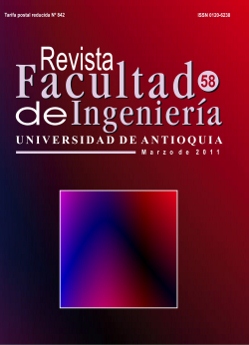Infl uence of castor oil mix composition on the production of biofuel
DOI:
https://doi.org/10.17533/udea.redin.14598Keywords:
castor oil, biofuel, densities, viscosity, combustion gasesAbstract
Castor oil trans esterifi cation has been evaluated as a source of alternative biodiesel. Three mixtures of biofuel (B5% B10% and B20%) were tested in a diesel engine. Power, fuel consumption, temperature and exhaust emissions were measured. Also, densities, viscosities, refractive indexes and combustion heats of the mixtures were determined. The use of biodiesel mixtures produces an increase of viscosity and fuel consumption, decreasing the heating and engine power, reducing the combustion gases like CO, CO2, sulfur oxides, hydrocarbons, and lowering the opacity of exhaust emissions. Additionally, a balance in the observed diesel engine performance was evidenced by the engine temperatures.
Downloads
References
J. W. Goodrum. “Volatility and boiling points of Biodiesel from vegetable oils and tallow”. Biomass Bioenergy. Vol 22. 2002. pp. 205-2011. DOI: https://doi.org/10.1016/S0961-9534(01)00074-5
C. E. Goering. “Fuel properties of eleven vegetable oils”. Transactions of the American Society of Agricultural Engineers (ASAE). Vol. 25. 1982. pp. 1472 - 1483. DOI: https://doi.org/10.13031/2013.33748
R. Altin, S. Cetinkaya, H.S. Yucesu. “The potential of using vegetable oil fuels as fuel for diesel engines”. Energy Convers Manage. Vol. 42. 2001. pp. 529-38. DOI: https://doi.org/10.1016/S0196-8904(00)00080-7
L. Louise. S. Sousa, L. Izabelly. L. Lucena, A.N. Fernández. “Transesterifi cation of castor oil: Effect of the acid value and neutralization of the oil with glycerol”. Fuel Processing Technology. Vol.91. 2010. pp. 194- 196. DOI: https://doi.org/10.1016/j.fuproc.2009.09.016
B. K. Barnwal, M. P. Sharma. “Prospects of biodiesel production from vegetable oils in India”. Renew Sustain Energy Rev. Vol 9. 2005. pp.363-378. DOI: https://doi.org/10.1016/j.rser.2004.05.007
P. R. Muniyappa, S. C. Brammer, H. Noureddini. “Improved conversion of plant oils and animal fats into biodiesel and co-product” Bioresour. Technol. Vol. 56. 1996. pp. 19-24. DOI: https://doi.org/10.1016/0960-8524(95)00178-6
A. Benavides, P. Benjumea, V. Pashova. “El Biodiesel de aceite de higuerilla como combustible alternative para motores biodiesel” Dyna. Vol. 154. 2007. pp. 141- 150.
C. L. Barajas. “Obtención de biodiesel a partir de la higuerilla (ricinus communis)”. 1er Seminario Internacional de Biocombustibles. Universidad Nacional de Colombia Sede Bogotá. 2004. pp. 64-69.
P. Benjumea, J. R. Agudelo, P. Zapata P. R. Mendoza. “Biodiesel: Una revisión del proceso de obtención mediante la transesterifi cación de aceites vegetales”. Revista Energética. N.o 29. 2003. pp 9-18.
G. Antolin, F.V. Tinant, Y. Briceño, V. Castaño, C. Pérez, A. I. Ramírez. “Optimization of biodiesel production by sunfl ower oil transesterifi cation”. Bioresour. Technol. Vol. 83. 2002. pp. 111-114.
M. I. Widyan, A. O. Shyoukh. “Experimentalevaluation of the transesterifi cation of waste palm oil into biodiesel”. Bioresour. Technol. Vol. 85. 2002. pp.253-256. DOI: https://doi.org/10.1016/S0960-8524(02)00135-9
F. Ma, L.D. Clements, H.A. Hanna. “The effect of mixing on transesterifi cation of beef tallow”. Bioresour. Technol. Vol. 69. 1999. pp. 289–293. DOI: https://doi.org/10.1016/S0960-8524(98)00184-9
B. Freedman, E.H. Pryde, T.L. Mounts. “Variables affecting the yields of fatty esters from transesterifi ed vegetable oils” JAOCS. Vol. 61. 1984. pp. 1638-1643. DOI: https://doi.org/10.1007/BF02541649
K. Li. “Preparation of fatty acid methyl esters for gas-chromatographic analysis of lipids in biological materials”. JAOCS. Vol. 71. 1994. 1179-1187. DOI: https://doi.org/10.1007/BF02540534
ASTM D1298 99. “Standard Test Method for Density, Relative Density (Specifi c Gravity), or API Gravity of Crude Petroleum and Liquid Petroleum Products by Hydrometer Method”. West Conshohocken. PA. American Society for Testing and Materials.2005.
ASTM D445 09. “Standard Test Method for Kinematic Viscosity of Transparent and Opaque Liquids (and Calculation of Dynamic Viscosity)”. West Conshohocken. PA. American Society for Testing and Materials. 2009.
Downloads
Published
How to Cite
Issue
Section
License
Copyright (c) 2018 Revista Facultad de Ingeniería

This work is licensed under a Creative Commons Attribution-NonCommercial-ShareAlike 4.0 International License.
Revista Facultad de Ingeniería, Universidad de Antioquia is licensed under the Creative Commons Attribution BY-NC-SA 4.0 license. https://creativecommons.org/licenses/by-nc-sa/4.0/deed.en
You are free to:
Share — copy and redistribute the material in any medium or format
Adapt — remix, transform, and build upon the material
Under the following terms:
Attribution — You must give appropriate credit, provide a link to the license, and indicate if changes were made. You may do so in any reasonable manner, but not in any way that suggests the licensor endorses you or your use.
NonCommercial — You may not use the material for commercial purposes.
ShareAlike — If you remix, transform, or build upon the material, you must distribute your contributions under the same license as the original.
The material published in the journal can be distributed, copied and exhibited by third parties if the respective credits are given to the journal. No commercial benefit can be obtained and derivative works must be under the same license terms as the original work.










 Twitter
Twitter